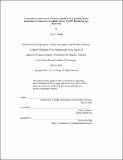| dc.contributor.advisor | Entekhabi, Dara | |
| dc.contributor.author | Zhang, Lily N. | |
| dc.date.accessioned | 2022-08-29T16:16:22Z | |
| dc.date.available | 2022-08-29T16:16:22Z | |
| dc.date.issued | 2022-05 | |
| dc.date.submitted | 2022-05-27T16:09:22.355Z | |
| dc.identifier.uri | https://hdl.handle.net/1721.1/144854 | |
| dc.description.abstract | Changes in surface properties are known to influence weather and climate through interactions between the land and atmosphere. In convective atmospheres, convective available potential energy (CAPE) drives convective adjustment and can lead to precipitation. We study the evolution of CAPE during drydowns, interstorm periods over which evapotranspiration occurs, to understand the impact of evaporative controls on convective adjustment. Our results show that drydown CAPE development varies geographically based on hydroclimate and can also depend on initial soil moisture content and moist enthalpy conditions. The impact of these factors on CAPE can be explained by their effect on evaporation, demonstrating the importance of evaporative controls on convective adjustment and providing a benchmark for understanding the relationship between soil moisture and precipitation. | |
| dc.publisher | Massachusetts Institute of Technology | |
| dc.rights | In Copyright - Educational Use Permitted | |
| dc.rights | Copyright retained by author(s) | |
| dc.rights.uri | https://rightsstatements.org/page/InC-EDU/1.0/ | |
| dc.title | Evaporative Controls on Convective Adjustment: A Satellite-Based Assessment of Convective Available Energy (CAPE) During Surface Drydowns | |
| dc.type | Thesis | |
| dc.description.degree | S.B. | |
| dc.contributor.department | Massachusetts Institute of Technology. Department of Earth, Atmospheric, and Planetary Sciences | |
| mit.thesis.degree | Bachelor | |
| thesis.degree.name | Bachelor of Science in Earth, Atmospheric, and Planetary Sciences | |
